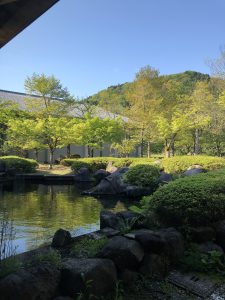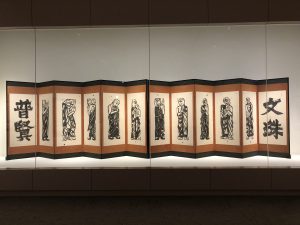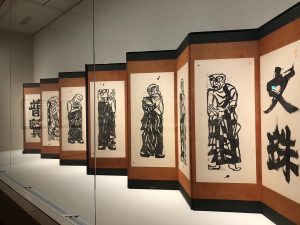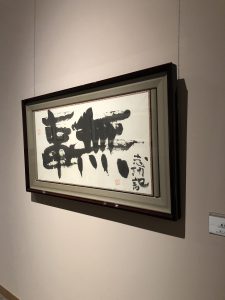棟方志功作品を大満喫した日でした。(愛知県名古屋市千種区姫池通 骨董買取いたします 古美術風光舎名古屋店)
2022.05.08
みなさまこんにちは、スタッフYでございます。
楽しみにしていた連休ももう終わり。
連休が終わり、明日からの日常を想像しますと灰色のメンタルになりそうな方、またもうお仕事や学校など始まってしまった方、はたまたこ連休中にお仕事などで忙しくし、これからやっとお休みをとられる方などなど、この週末はなんとも悲喜こもごものの週末の風景ではないでしょうか。お天気だけは良いというのに…。
私を含め灰色のメンタルの皆さま、これを乗り切る次なる目標を早く見つけ、頑張って日常にもどっていきましょう。

さてさて、先日の富山県の散居村夕陽の風景をご報告いたしましたが、実はもうひとつ訪れたところがございまして。
富山県南砺市にございます福光美術館で開催されております、「志功と俊彦の物語」展へ行ってまいりました。
棟方志功自身はは青森の出身ではありますが、志功が何故にこの福光に縁がございますかと申しますと、志功は家族と共に疎開にて福光町に約7年にわたって生活しており、その間この地の自然や人々をこよなく愛し、多くの作品を残しております。
この時代を経て彼は東京に帰還後、国際美術展でグランプリ獲得を重ね、やがて“世界のムナカタ”とも称されるほど活躍するのですが、福光時代に制作された数々の作品は、富山県外ではあまり紹介されていないようでして、この美術館では棟方作品として有名な板画(はんが:版画)のほか、倭画(やまとが:肉筆画)、油絵、書、書簡などの多くの作品を所蔵しております。
志功は「福光は私の第二のふるさと」と、晩年まで懐かしんでおりましたが、当時の志功の暮らしを静かに支え続けていたのが石崎俊彦でありました。
「気難しい人」と思われがちな俊彦のようでしたが、彼と志功がどのように信頼関係を結び、生涯の友となっていったのか。かつて志功が住んでいた住居「鯉雨画斎」を棟方志功記念館愛染苑として設立した俊彦の素顔と一緒に、志功が富山で残してきた多くの作品を今回は企画展にて展示しております。当の愛染苑へは、散居村の夕陽の時間の都合断念いたしましたが、こちらは次回の課題として残しておきましょう。

さてさて入っていきましょう。
こちらの美術館は初めてだったもので、知らずに常設展からはいっていました。といいましても、常設展が立派であります。シックな館内をゆっくりと贅沢に棟方志功氏の作品を鑑賞できるなんて贅沢な空間であります。
どれから紹介しようかと思っておりますと、まず、空間に入った正面に「二菩薩釈迦十大弟子(にぼさつしゃかじゅうだいでし)」が。
作品が沢山ありますので、本日は、こちらのを一緒に鑑賞いたしましょう。ありがたいことにここ最近、美術館もお写真大丈夫のところが多くなりまして、こちらもお写真を撮らせていただきました。

「二菩薩釈迦十大弟子(にぼさつしゃかじゅうだいでし)」
1939年(昭和14年)/板画(南砺市立福光美術館寄託)
もともと制作したのは昭和14(1939)年。文殊菩薩・普賢菩薩と、釈迦の10人の高弟の姿を彫ったもので、棟方志功36歳の時の作品であるのですが、のちに、昭和30(1955)年、サンパウロ・ビエンナーレ国際美術展で版画部門最高賞を受賞。さらに、翌年の昭和31(1956)年のヴェネツィア・ビエンナーレ国際美術展にて、グランプリの国際版画大賞をも受賞する大作であります。有名な作品ですよね。
表裏に彫ってあるのですが、10人の弟子が5枚の板木に彫っているそうで、当時は戦時中。この作品は戦前、東京で描かれたものですが、なぜここ富山にあるのかと申しますと。

疎開騒ぎの中、荷物を田舎に送りたいって駅がごった返しているのですが、持ち込めるのは5点だけということで、美術品とか骨董品とか生活必需品でないものは後回しとなり、どうしても生活に必要なものだけということに。
どう考えても板画の板木は見逃してくれないだろうと考えたのですが、さすがに飯のタネといえども、なかなか他人には分かってもらえないだろうし、どうしたものかと思ったところ、ここで救世主となったのが、志功氏の奥様である「チヤ夫人」。
奥様が知恵を働かせ、背もたれの長いスピンドルチェアの添え木にして、持ってくるんですね。それがちょうど5脚でして、5枚をぐるぐる巻きにしてなんとか富山に辿り着くという…。
当時、彼が大切にしていたイギリスのウインザー調のチェアのようですが、その梱包用の材料として、機転を利かして無事に輸送されることになったのですが、その後送り出した奥様や子供たちが代々木の自宅から福光へと向かったのが昭和20(1945)年5月24日。
なんとその翌日東京は大空襲に見舞われてしまいます。板木はもちろん、奥様も間一髪という状況だったようでして、奇跡的に残っているのが、唯一福光に避難できた板木で、この十大弟子。
両端が「書」となっておりますがこちらは板木が焼けてしまったため、のちに文殊菩薩と普賢菩薩を改刻し出展され、この作品は世界的な有名な賞をとり、『世界のムナカタ』に名を馳せる作品になります。
実際みてみますと、たいへん大きく大胆な作品ですが、当時これを戦時中の騒然とした疎開下の中、運ぼうと必死であった家族の様子のこと、ここ富山になんとか無事たどり着いたこと、世界的な賞を取り世界の人々の目に留まったこと、そして今こうして静かな美術館の空間の中、私がこうして目の前にてこの作品を眺めていることが不思議でなりません。このような穏やかな作品が、ほんとうに戦時下を潜り抜けてきたのだろうかと。
どんな作品にも越えてきた歴史があるでしょうが、この作品が生き延びてきた様々な出来事などを思いながら、今は静かな空間の中、10人の菩薩のご尊顔がことのほか穏やかに見えてなりませんでした。
それに比べ、たかが連休明けで灰色のメンタルでいる自分、実にいかんいかん…。穏やかに微笑えもうではないか。

それでは、ごきげんよう。
Hello everyone, this is Staff Y.
The holidays I was looking forward to are over. Those who are likely to have a gray mentality when the holidays are over and imagine the daily life from tomorrow, those who have already started work or school, or those who happen to be busy with work during the holidays, from now on For those who can finally take a day off, this weekend is a sad and happy weekend. Only the weather is good …
Gray mentals, including myself, let’s find the next goal to overcome this as soon as possible, and do our best to return to our daily lives.
By the way, I reported on the scenery of the sunset in the dispersed village of Toyama Prefecture the other day, but in fact, I visited another place, which is being held at the Fukumitsu Museum of Art in Nanto City, Toyama Prefecture.
I went to the “Story of Shiko and Toshihiko” exhibition.
Munakata Shiko himself is from Aomori, but when asked why Shiko has a connection with this Fukumitsu, Shiko has lived in Fukumitsu-cho with his family for about seven years, and during that time he has lived here. He loves nature and people, and has left many works.
After returning to Tokyo after this era, he won the Grand Prix at an international art exhibition, and eventually became active enough to be called “Munakata of the World”, but many works produced during the Fukumitsu era are outside Toyama Prefecture. It seems that it has not been introduced so far, and in this museum, in addition to the famous woodblock prints (hanga: prints), there are many paintings (yamatoga: hand-painted paintings), oil paintings, books, letters, etc. We have the works of.
Shiko was fond of “Fukumitsu is my second hometown” until his later years, but it was Toshihiko Ishizaki who quietly supported the life of the builder at that time. He was like Toshihiko, who is often thought of as a “difficult person,” but how did he and Shiko form a relationship of trust and become a lifelong friend? Along with the true face of Toshihiko, who established the residence “Koiame Gakusai” where Shiko once lived as the Munakata Shiko Memorial Hall Aizenen, many works left by Shiko in Toyama will be exhibited at this exhibition. We are here. I gave up on the Aizen-en because of the sunset time in the dispersed village, but let’s leave this as the next task.
Well, let’s go in.
This was the first time for me to enter this museum, and I entered it from the permanent exhibition without knowing it. Even so, the permanent exhibition is excellent. It is a luxurious space where you can slowly and luxuriously appreciate the works of Mr. Shiko Munakata in the chic hall.
When I was thinking about which one to introduce, first of all, in front of the space, there was “Ten Bodhisattva Buddha Disciples”. There are many works, so let’s enjoy them together today. Thankfully, recently, there are many museums where it’s okay to take pictures, so I took pictures here as well.
“Ten Bodhisattva Disciples” 1939 (Showa 14) / Board painting (deposited at Nanto City Fukumitsu Museum)
It was originally produced in 1939 (Showa 14). It is a carved figure of Manjushri, Samantabhadra, and 10 high-ranking brothers of Buddha. It was a work when Munakata Shiko was 36 years old. Later, in 1955, Sao Paulo Biennale International Received the highest award in the print category at an art exhibition. In addition, it is a masterpiece that won the Grand Prix International Print Award at the Venice Biennale International Art Exhibition in 1956 the following year. It’s a famous work, isn’t it?
It is carved on the front and back, but it seems that 10 disciples are carving on 5 boards, and it was during the war at that time. This work was drawn in Tokyo before the war, but why is it here in Toyama?
The station is crowded with people wanting to send their luggage to the countryside in the midst of the turmoil, but since only 5 items can be brought in, art, antiques, and non-necessary items are put off and are absolutely necessary for daily life. It’s just something that isn’t.
I thought that the woodblock prints wouldn’t be overlooked by any means, but I wondered what happened when I thought that even the seeds of rice wouldn’t be easily understood by others. The savior here was Mrs. Chiya, the wife of Mr. Shiko.
Your wife will use her wisdom to splint her long-backed spindle chair and bring it with you. She said that it was just 5 legs, and she managed to reach Toyama by winding 5 pieces around.
It seems to be a Windsor-style chair in England that he cherished at that time, but as a material for packing it, it was supposed to be transported safely, but the wives and children who sent it out after that. It was May 24, 1945 that he headed for Fukumitsu from his home in Yoyogi.
The next day, Tokyo was hit by a large air raid. It seems that not only Itaki but also his wife had a close call, and the only one that miraculously remains is Itaki, who was able to evacuate to Fukumitsu, and these ten major disciples.
Both ends are “calligraphy”, but since the board was burnt, the Manjushri and Samantabhadra were later reprinted and exhibited, and this work later won a world-famous award. It will be a work that is famous for “Munakata of the World”.
Actually, it is a very big and bold work, but at that time it was a state of the family desperate to carry it in the noisy evacuation during the war, the fact that I managed to reach here in Toyama, the world It’s no wonder that it won a prize and caught the eye of the people of the world, and that I’m looking at this work in front of me in this quiet museum space.
Every work has a history that has been surpassed, but while thinking about the various events that this work has survived, the faces of the 10 bodhisattvas now look extremely calm in a quiet space. did not.
I don’t really care about myself, who is gray mentally after the holidays. Let’s smile gently.
*********************
爽やかなお天気が続いておりますね。お片付けなどされてる方もおおいのではないでしょうか。
風光舎では、古美術品や骨董品の他にも絵画や宝石、趣味のお品など様々なジャンルのものを買受しております。
お片付けをされていて、こういうものでもいいのかしらと迷われているものでも、どうぞお気軽にご相談下さいませ。
また風光舎は、出張買取も強化しております。
ご近所はもちろん、愛知県内、岐阜県、三重県その他の県へも出張いたします。
まずは、お電話お待ちしております。
愛知県名古屋市千種区・骨董 買取
『古美術 風光舎 名古屋店』

